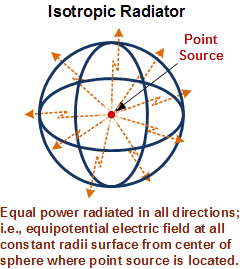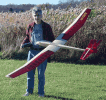Effective isotropic radiated power (sometimes also referred to as equivalent isotropic radiated power),
is a commonly used unit when specifying antenna efficiency (gain).

In order to provide a common reference for radiated power, an ideal isotropic radiator is used as the standard.
An isotropic radiator emits power from a singular point (dimensionless) whose wavefront is a perfect sphere of constant
voltage (or power for equal impedances). Any gain specified for an antenna represents a concentration of the radiation
pattern in a given direction. EIRP is calculated as follows:

where Power (dBm or dBW), Loss (dB), Gain (dBi)
Most antenna types; e.g., parabolic, Yagi, log periodic, have gains based on many physical parameters. A few
common antenna types are fixed in physical dimensions and have well-known gains when positioned optimally above
a ground plane; e.g.,1/4-wave monopole and 1/2-wave dipole antennas have gains of 2.15 dBi.
Sometimes, especially in the amateur radio world, antenna gains are expressed in units of dBd, which is decibels
relative to a ½-wave dipole antenna. This is because the ½-wave dipole is thought of as a standard
when discussing transmitter and receiver performance.
|









